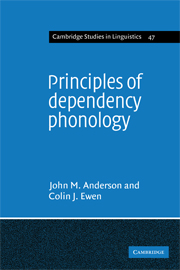Introduction
Published online by Cambridge University Press: 04 August 2010
Summary
Our primary aim in Part II will be to work out some of the notions partially developed in chapters 1 and 3, i.e. those concerned with the structure of segmental representations in dependency phonology. Before we can discuss any further the nature of the phonological primes and their interaction, however, we must devote some space to refining the notion of gesture, which we considered in a preliminary way in §1.6. In particular, we must establish exactly how many gestures are required, and how the components characterising a segment are divided amongst them.
In §1.6 we noted that both Lass (1976) and Lass & Anderson (1975) propose that the matrix characterising a segment be divided into (at least) two sub-matrices – the articulatory gesture and the phonatory gesture – and that phonological rules and processes may have as their domain just one of these gestures. Further, we noted that [?] and [h] can be characterised as lacking all supralaryngeal articulatory information, so that rules changing voiceless stops to [?], or voiceless fricatives to [h], involve merely deletion of all articulatory features–the resulting segment being specified only for features in the phonatory gesture. In other words, [?] is viewed as the ‘minimal’ stop and [h] as the ‘minimal’ fricative.
Notice, however, that the proposal made by Lass differs in some interesting ways from that of Lass & Anderson. Instead of two gestures labelled [articulatory] and [phonatory], he proposes an [oral] and a [laryngeal] gesture.
- Type
- Chapter
- Information
- Principles of Dependency Phonology , pp. 141 - 150Publisher: Cambridge University PressPrint publication year: 1987



